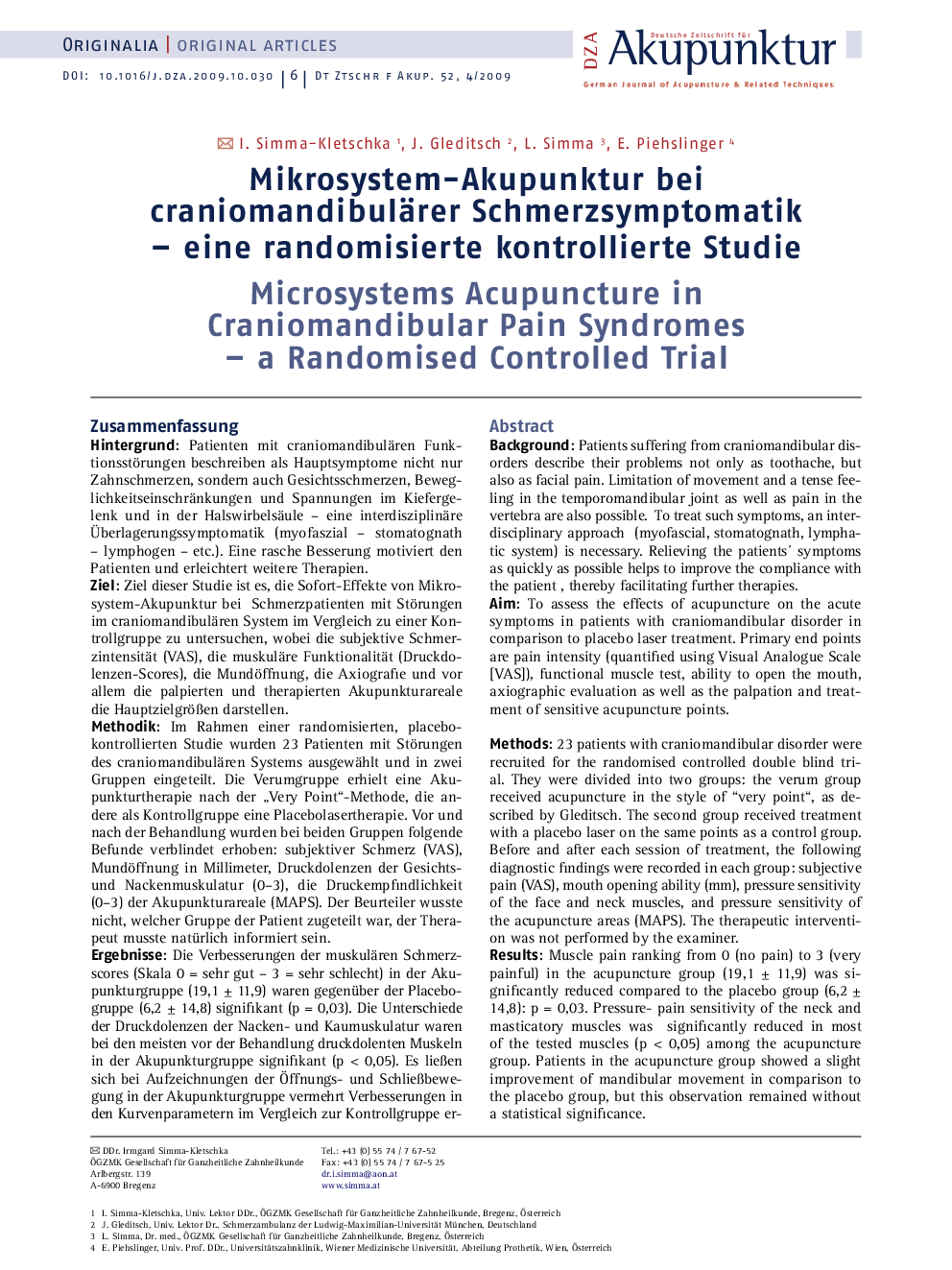| کد مقاله | کد نشریه | سال انتشار | مقاله انگلیسی | نسخه تمام متن |
|---|---|---|---|---|
| 2616311 | 1135170 | 2009 | 6 صفحه PDF | دانلود رایگان |

ZusammenfassungHintergrundPatienten mit craniomandibulären Funktionsstörungen beschreiben als Hauptsymptome nicht nur Zahnschmerzen, sondern auch Gesichtsschmerzen, Beweglichkeitseinschränkungen und Spannungen im Kiefergelenk und in der Halswirbelsäule – eine interdisziplinäre Überlagerungssymptomatik (myofaszial – stomatognath – lymphogen – etc.). Eine rasche Besserung motiviert den Patienten und erleichtert weitere Therapien.ZielZiel dieser Studie ist es, die Sofort-Effekte von Mikrosystem-Akupunktur bei Schmerzpatienten mit Störungen im craniomandibulären System im Vergleich zu einer Kontrollgruppe zu untersuchen, wobei die subjektive Schmerzintensität (VAS), die muskuläre Funktionalität (Druckdolenzen-Scores), die Mundöffnung, die Axiografie und vor allem die palpierten und therapierten Akupunkturareale die Hauptzielgrößen darstellen.MethodikIm Rahmen einer randomisierten, placebo-kontrollierten Studie wurden 23 Patienten mit Störungen des craniomandibulären Systems ausgewählt und in zwei Gruppen eingeteilt. Die Verumgruppe erhielt eine Akupunkturtherapie nach der „Very Point”-Methode, die andere als Kontrollgruppe eine Placebolasertherapie. Vor und nach der Behandlung wurden bei beiden Gruppen folgende Befunde verblindet erhoben: subjektiver Schmerz (VAS), Mundöffnung in Millimeter, Druckdolenzen der Gesichts- und Nackenmuskulatur (0–3), die Druckempfindlichkeit (0–3) der Akupunkturareale (MAPS). Der Beurteiler wusste nicht, welcher Gruppe der Patient zugeteilt war, der Therapeut musste natürlich informiert sein.ErgebnisseDie Verbesserungen der muskulären Schmerzscores (Skala 0 = sehr gut – 3 = sehr schlecht) in der Akupunkturgruppe (19,1 ± 11,9) waren gegenüber der Placebogruppe (6,2 ± 14,8) signifikant (p = 0,03). Die Unterschiede der Druckdolenzen der Nacken- und Kaumuskulatur waren bei den meisten vor der Behandlung druckdolenten Muskeln in der Akupunkturgruppe signifikant (p < 0,05). Es ließen sich bei Aufzeichnungen der Öffnungs- und Schließbewegung in der Akupunkturgruppe vermehrt Verbesserungen in den Kurvenparametern im Vergleich zur Kontrollgruppe erkennen. Auch bei der Protrusions- und Retrusionsbewegung zeigten sich in der Akupunkturgruppe vermehrt Verbesserungen, allerdings waren diese nicht statistisch signifikant.SchlussfolgerungAufgrund der Ergebnisse der vorliegenden Studie ist die Akupunktur ein geeignetes Mittel zur Akuttherapie bei craniomandibulären Störungen. Weitere Studien mit größerer Patientenzahl und Untersuchungen der Langzeitwirkungen sind in Arbeit.
BackgroundPatients suffering from craniomandibular disorders describe their problems not only as toothache, but also as facial pain. Limitation of movement and a tense feeling in the temporomandibular joint as well as pain in the vertebra are also possible. To treat such symptoms, an interdisciplinary approach (myofascial, stomatognath, lymphatic system) is necessary. Relieving the patients' symptoms as quickly as possible helps to improve the compliance with the patient, thereby facilitating further therapies.AimTo assess the effects of acupuncture on the acute symptoms in patients with craniomandibular disorder in comparison to placebo laser treatment. Primary end points are pain intensity (quantified using Visual Analogue Scale [VAS]), functional muscle test, ability to open the mouth, axiographic evaluation as well as the palpation and treatment of sensitive acupuncture points.Methods23 patients with craniomandibular disorder were recruited for the randomised controlled double blind trial. They were divided into two groups: the verum group received acupuncture in the style of “very point”, as described by Gleditsch. The second group received treatment with a placebo laser on the same points as a control group. Before and after each session of treatment, the following diagnostic findings were recorded in each group: subjective pain (VAS), mouth opening ability (mm), pressure sensitivity of the face and neck muscles, and pressure sensitivity of the acupuncture areas (MAPS). The therapeutic intervention was not performed by the examiner.ResultsMuscle pain ranking from 0 (no pain) to 3 (very painful) in the acupuncture group (19,1 ± 11,9) was significantly reduced compared to the placebo group (6,2 ± 14,8): p = 0,03. Pressure- pain sensitivity of the neck and masticatory muscles was significantly reduced in most of the tested muscles (p < 0,05) among the acupuncture group. Patients in the acupuncture group showed a slight improvement of mandibular movement in comparison to the placebo group, but this observation remained without a statistical significance.ConclusionThis RCT shows that acupuncture with the „very point” method can improve symptoms of craniomandibular disorders within a short period of time. Further studies are necessary and projected to prove the long term effect within a larger group of patients.
Journal: Deutsche Zeitschrift für Akupunktur - Volume 52, Issue 4, 2009, Pages 6–11